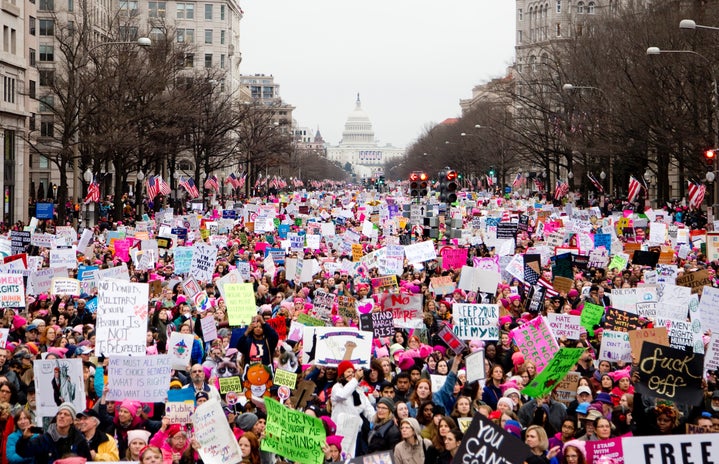The opinions expressed in this article are the author’s own.
One in three women will have an abortion at some point in their life. Yet abortion restrictions are becoming increasingly frequent in the United States, and in many countries, it remains completely illegal. Despite the frequency at which abortion happens, and the health and social risks that come with restricting or banning it, it remains a taboo and controversial subject people are reluctant to discuss.
For women’s history month, I wanted to write about why I support pro-choice policies, and why “pro-life” policies, almost always passed without the input of females, are a public health crisis that fails to effectively lower abortion and unplanned pregnancy rates.
Pregnancy is dangerous
Pregnancy and childbirth can present serious mental and physical health complications, even in women with no pre-existing conditions who have access to the best medical care in the world.
According to the National Institute of Health, some common pregnancy complications include high blood pressure, gestational diabetes, infections, preeclampsia (high blood pressure and damage to organ systems, sometimes leading to fatal complications for mother and baby), preterm labor, miscarriage, hyperemesis gravidarum (nausea that does not go away, along with weight loss, reduced appetite, and dehydration) and iron deficiency.
These complications, along with other ones, increase if the mother has any pre-existing conditions such as heart disease, cancer, or a disability. Pregnancy can be especially dangerous for teenagers, whose bodies aren’t developed enough to handle childbirth and women who are in their late thirties or early forties.
In more developed countries, death during childbirth is increasingly rare, yet the maternal mortality rate in the United States, while still low, is increasing. And women of color are far more likely to experience complications and death during childbirth than white women.
Pregnancy affects everyone’s body differently, and there isn’t always a way to detect these risks early on in gestation. Having a baby can be one of the most beautiful and rewarding moments in a person’s life, but it does place significant stress on your body and should always be a choice, without any input from the government.
Pregnancy is expensive
The United States, despite being one of the richest countries in the world, is one of the most expensive countries to give birth and raise a child in.
Believe it or not, we are one of two countries in the entire world that doesn’t guarantee paid maternity leave to parents. Some mothers are expected to return to work in as little as one month after giving birth, a very short period of time to recover and bond with their child. Those who aren’t so lucky might be forced to use vacation or sick days and have even less time. And some might be out of a job altogether.
Even with insurance, giving birth in the United States, depending on which state you live in, can cost an average of $4,500, according to a study done by Health Affairs. Not to mention the cost of childcare ranges from $9,000-$9,600 a year –more than college tuition in twenty-eight states.
Abortion bans hurt women and children
Women have been performing abortions on themselves for thousands of years, long before we had trained medical professionals around to do it safely. Before abortion became legal, it was common for women to resort to unsafe methods of abortion such as:
-
Puncturing the amniotic sac using a sharp object such as a coat hanger or knitting needle
-
Pumping toxic chemicals such as alum, lysol, permanganate, or plant poison into the body
-
Taking unprescribed, illegal drugs that result in miscarriage or uterine contractions
The health risks of unsafe abortions include infection, hemorrhaging, and injury to internal organs. Left untreated, these symptoms might result in infertility or even death. In a study, the World Health Organization estimates that twenty-five million unsafe abortions take place around the world every year, accounting for 45% of the total amount of abortions performed from 2010-2014. The vast majority of these abortions were performed in developing countries, where abortion is illegal.
“When women and girls cannot access effective contraception and safe abortion services, there are serious consequences for their own health and that of their families. This should not happen. But despite recent advances in technology and evidence, too many women continue to suffer and die.” -Dr.Bela Ganatra, lead author of the study and a scientist in the WHO Department of Reproductive Health and Research.
Restricting and banning abortion only decreases the number of safe abortions performed. When abortion is banned, women will resort to illegal methods, even if it means risking their own health or facing legal repercussions.
Another study that was done by the Guttmacher Institute concluded that countries with highly restrictive abortion laws actually have very similar (and often higher) rates of abortion compared to countries with fewer restrictions. According to the study:
“Abortion incidence varies little by countries’ economic conditions: Rates are similar among the World Bank’s four income groups—the highest and lowest income groups range narrowly (rates of 29 and 32 per 1,000 women, respectively). Moreover, women living under the most restrictive laws (i.e., where abortion is prohibited altogether or allowed only to save a woman’s life) have abortions at about the same rate as those living where the procedure is available without restriction as to reason (37 and 34 abortions per 1,000, respectively)
“Pro-life” policies still result in the same amount or even more abortions than pro-choice ones, yet they are done unsafely and can result in the death of the mother. So is increasing the maternal mortality rate really pro-life? Especially considering that 61% of women who obtain abortions already have kids?
One goal I think both sides of the debate should work towards is lowering the rate of unplanned pregnancies, which by default will lower the abortion rate. The best way to achieve this goal is to increase access to affordable contraceptives, provide comprehensive sex education in schools, and provide families with paid parental leave and affordable healthcare.
The Netherlands currently does all of this. Abortion there is almost completely covered under their healthcare plan, yet their abortion rate is one of the lowest in the world, currently at about 8 abortions per 1000 women. In comparison, the United States stands at 13.5 as of 2017.
The United States currently has no standard for sex education in public schools. Only 22 states mandate that students receive it at all, and of those 22 only 13 require it to be medically accurate. It’s no surprise that states with abstinence-only education have higher teen pregnancy rates and no impact on the rates of teen abstinence.
In 2019, the state of Colorado began allocating state funds to cover the cost of IUDs (Intrauterine devices that provide long term pregnancy prevention), to make them more accessible to low-income women and teenagers. Consequently, Colorado saw a 20% decline in teen pregnancies.
However, many health professionals who work in clinics that provide this type of reproductive care have expressed concerns over lack of funding. The Trump administration has repeatedly tried to cut funds from Planned Parenthood and similar clinics due to their commitment to providing abortions. Yet despite the existence of the Hyde Amendment, preventing federal funds from going towards abortions (except in the cases of rape, incest, and life of the mother) many Planned Parenthood clinics don’t even provide abortions. Thousands of women rely on these clinics and other health centers for birth control (again, something that prevents pregnancies) STD testing, and cancer screenings. Not to mention that investing in reproductive health saves our country money.
The lack of funding for these clinics, often the only ones many low-income women can afford, means that too often they shut down. Women seeking affordable reproductive care, especially abortions, are forced to drive longer distances and take more time off work. This coupled with mandatory waiting periods result in abortions being performed later on in the pregnancy, where the fetus is more developed and the mother must pay even more for what should have been a less complicated and expensive procedure.
Regardless of how you identify, statistics show that policies that prevent women from obtaining abortions only cause more pain and suffering. We must focus on education and healthcare accessibility. Abortion will happen regardless of what policies are put into place; we can’t control that. But we can decrease the number of abortions that are performed unsafely and lower unplanned pregnancy rates significantly.
If you haven’t already, make sure to vote in the 2020 election to ensure women all over the United States receive access to safe and affordable reproductive care. Happy Women’s history month!



